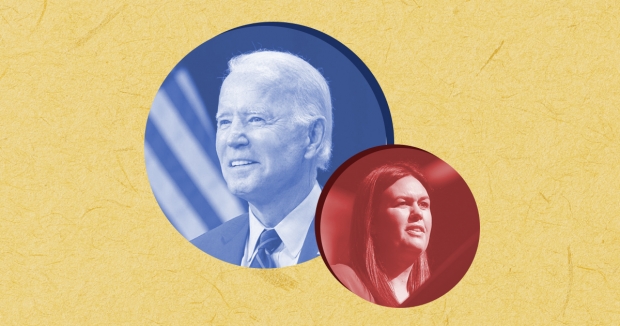The State of the Union Was Supposed To Be Nonpartisan. Can It Be, Again?

This view is from an author rated Lean Left.
On Tuesday, President Joe Biden will deliver the annual State of the Union address — which, on paper, aims to discuss the current condition of the nation. Shortly thereafter, Arkansas Gov. Sarah Huckabee Sanders will deliver the Republican Party’s response, continuing a tradition of response speeches by the major party opposing the sitting president.
If the first speech simply discusses the country’s progress, why is a partisan response necessary?
The answer, of course, is that the president’s speech tends to lean into their party’s priorities, and the opposing party usually wants to get in a word or two. But could these bulwarks against one-sidedness be reinforcing the partisanship they aim to counter?
The State of the Union address and opposing-party responses have a long history. Article II, Section 3 of the U.S. Constitution states that the President (notably referred to as “He”) “shall from time to time give to the Congress Information of the State of the Union, and recommend to their Consideration such Measures as he shall judge necessary and expedient.”
President George Washington delivered the first annual address in 1790. It was generally known as “the President’s Annual Message to Congress” until the 1940s, when the name “State of the Union” was popularized during Franklin D. Roosevelt’s presidency.
In the early days, the address was not a public affair, but a statement made by the president to Congress. As such, the key division was not between partisan factions, but between the executive and legislative branches of government.
Then, as technology advanced, a new participant was introduced: the public.
President Calvin Coolidge’s 1923 annual address was the first to be broadcast nationally on radio, and President Harry S. Truman's 1947 address was the first to be broadcast on television.
In an analysis published by The Washington Post (Lean Left bias) in 2018, researchers Connor M. Ewing and Charles Zug argued that televising the State of the Union changed the dynamic of the president’s annual address. Just as the internet changed how politics was conducted, television opened up previously-insulated political processes to the public eye.
If you’re a fan of transparency, that sounds great. But according to Ewing and Zug, this new public attention “shifted the president’s focus from the legislature in front of him to the voting public beyond them.”
If you’re speaking to a legislature, your goal is likely to get members to vote for policies you support, because that’s what legislators do. They vote on policies. If you’re speaking to the voting public, your goal is likely to get Election Day votes for yourself and your political allies, because that’s what voters do. They vote for candidates.
As government became more accessible to the public, politics itself became less about legislative action and more about elections — the realm of partisanship.
The response speech, contrary to the State of the Union address, was always and inherently partisan. Understanding how this practice began can help us understand what we’ll hear from Sarah Huckabee Sanders on Tuesday.
The informal tradition began with Sen. Everett Dirksen (R-Ill.) and Rep. Gerald Ford’s (R-Mich.) response to Democratic President Lyndon B. Johnson’s annual address in 1966 — around the time when modern Democrat-vs-Republican polarization began growing, by some measures.
Dirksen and Ford’s speech, titled “The State of the Union — A Republican Appraisal,” was delivered and televised on January 17, five days after Johnson’s address.
Dirksen focused on international issues, calling for increased scrutiny of foreign aid and committing to the Vietnam War, despite it being “not our war,” while also calling for peace talks.
Ford, who would later go on to become the 38th president, noted that the Republicans were a “minority party” — Democrats held a ⅔ majority in both houses of Congress. Focusing on domestic issues, Ford laid out several priorities that may seem eerily similar to today’s issues: “how to increase jobs and output without inflation,” “how to move ahead toward equality for all citizens,” and “how to improve government and its services.” Some of his priorities, however, might be unrecognizable to some members of today’s GOP; they included “a federal income tax credit for college students and their parents” to “ease the financial burden of going to college.”
Notably, President Johnson’s address that year did not include much partisan language. It didn’t need to — Democratic congressmen had the votes to pass what they could agree on, with or without Republican congressmen. The Republican response, on the other hand, was likely born out of a need to appeal to the State of the Union’s new public audience — which had the power to vote more Republicans into office.
Three years and a deeply controversial war later, voters chose a Republican for president.
Fast-forward to today, and both the State of the Union and the opposing party’s response are viewed as deeply partisan occasions. When Biden touts his administration’s accomplishments on Tuesday, Democrats will probably applaud and Republicans will probably stay silent — if not boo. Only certain issues, like praising military veterans, will get cheers from both sides of the room.
It isn’t necessary that Democrats and Republicans sit separately; in 2011 and 2012, 60 and 160 lawmakers agreed to mix up their seating arrangements in an effort championed by Sens. Mark Udall (D-Colo.) and Lisa Murkowski (R-Alaska). Congress has since gone back to the usual partisan seating arrangement.
Once Biden’s speech ends, the Republican response will begin — another exercise in partisan separation. Loyal Republican voters will likely see the speech as balancing out the State of the Union’s partisanship, but notably, the response speech only works as a counterweight if Biden’s speech functions as the Democrats’ speech. Many would argue it does.
By countering the State of the Union, however, the opposition party also deepens the president’s incentives for partisanship in the original speech. Remember: the president’s address was intended not for partisanship, but for giving information and recommendations to Congress. Not to Democrats, not to Republicans — to Congress as a whole.
The response speech is an adaptation to a more partisan political landscape. It helps us survive polarization by showing us both sides (although I highly doubt many Democratic voters will watch Tuesday’s Republican response). This is incredibly useful, as anyone at AllSides will tell you. However, that’s all it does. It helps us understand what the divisions are, but it doesn’t tell us how to resolve them.
What is lacking is a way to heal the partisanship that infected our institutions in the first place. Without that, all we’re doing is watching two powerful factions boo each other.
It’s a classic playground “well, he started it” dilemma. To resolve the dispute, someone has to be the first to pull back. Generally, it doesn’t particularly matter who, but in the case of the State of the Union address, the primary burden is on the president. Biden’s speech is the main event, and it will come before Sanders’, so he has the main opportunity to heal the divide.
On this count, there’s some room for hope. According to anonymous advisers who spoke to The New York Times (Lean Left bias), Biden plans to present himself on Tuesday as “the adult in the room, willing and able to reach bipartisan compromises in an age of deep partisanship.” The Times continues: “He will point to legislation he signed with Republican support since taking office and call on Speaker Kevin McCarthy and the G.O.P. majority that won control of the House in November’s midterm elections to follow that example.”
However, the Times adds: “But knowing that any such cooperation is unlikely from a caucus that claims a mandate to resist him at every turn, Mr. Biden’s advisers expect him to try to draw a mature contrast to squabbling, angry Republicans divided over the election of Mr. McCarthy as speaker and more intent on investigating Hunter Biden than advancing the nation’s business.”
This is not the first time Biden has pledged to champion bipartisanship and national unity. In his inauguration speech, Biden proclaimed that “unity is the path forward” through “our historic moment of crisis and challenge.”
However, many Republicans (including some here at AllSides) were disappointed by these pledges, particularly when it came to Biden’s support of key legislation supported by Democrats and opposed by Republicans.
Thus, words alone may not be effective. Even if Biden’s 2023 State of the Union ends up being the most forceful call for unity in U.S. history, will Republican and Democratic politicians change their behavior? Will party-aligned voters care? It remains to be seen.
Joseph Ratliff is a Daily News Editor at AllSides. He has a Lean Left bias.
This piece has been reviewed by Managing Editori Henry A. Brechter (Center bias), CEO John Gable (Lean Right bias), and News Editor Isaiah Anthony (Center Bias).


May 6th, 2024

May 6th, 2024

May 3rd, 2024